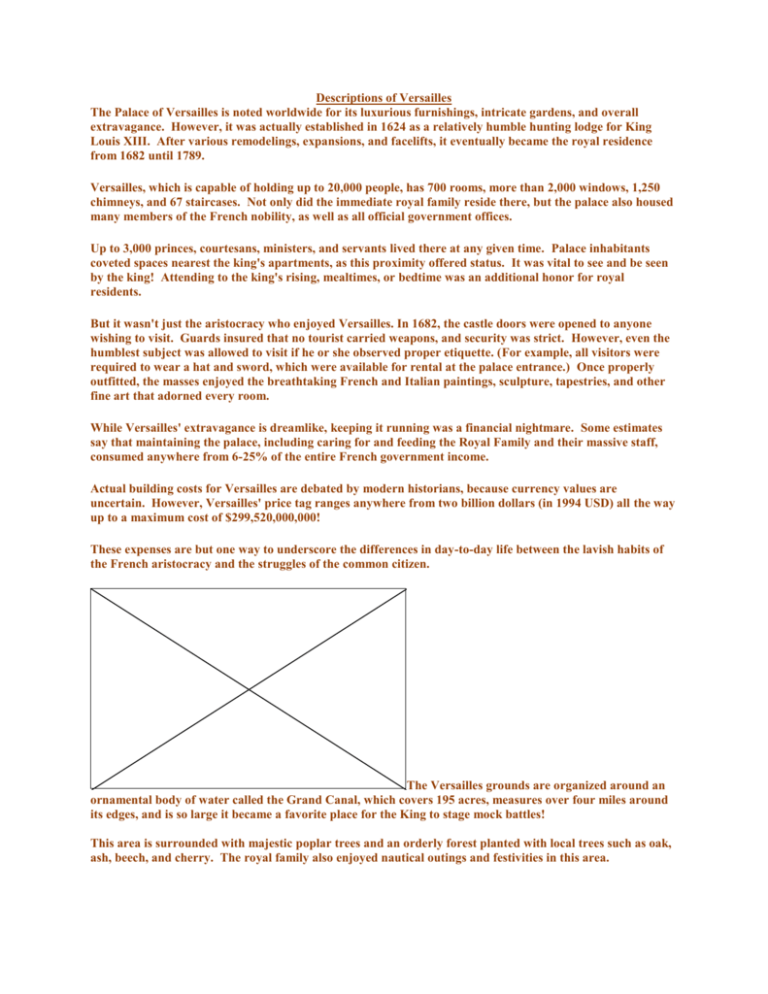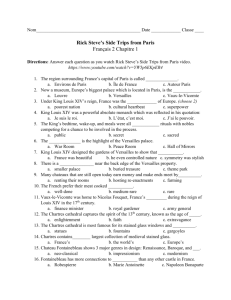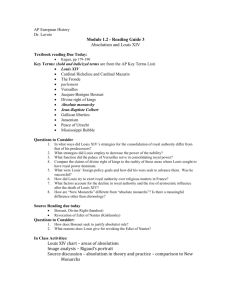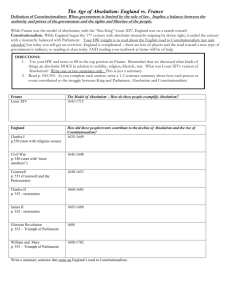Descriptions of Versailles The Palace of Versailles is noted
advertisement

Descriptions of Versailles The Palace of Versailles is noted worldwide for its luxurious furnishings, intricate gardens, and overall extravagance. However, it was actually established in 1624 as a relatively humble hunting lodge for King Louis XIII. After various remodelings, expansions, and facelifts, it eventually became the royal residence from 1682 until 1789. Versailles, which is capable of holding up to 20,000 people, has 700 rooms, more than 2,000 windows, 1,250 chimneys, and 67 staircases. Not only did the immediate royal family reside there, but the palace also housed many members of the French nobility, as well as all official government offices. Up to 3,000 princes, courtesans, ministers, and servants lived there at any given time. Palace inhabitants coveted spaces nearest the king's apartments, as this proximity offered status. It was vital to see and be seen by the king! Attending to the king's rising, mealtimes, or bedtime was an additional honor for royal residents. But it wasn't just the aristocracy who enjoyed Versailles. In 1682, the castle doors were opened to anyone wishing to visit. Guards insured that no tourist carried weapons, and security was strict. However, even the humblest subject was allowed to visit if he or she observed proper etiquette. (For example, all visitors were required to wear a hat and sword, which were available for rental at the palace entrance.) Once properly outfitted, the masses enjoyed the breathtaking French and Italian paintings, sculpture, tapestries, and other fine art that adorned every room. While Versailles' extravagance is dreamlike, keeping it running was a financial nightmare. Some estimates say that maintaining the palace, including caring for and feeding the Royal Family and their massive staff, consumed anywhere from 6-25% of the entire French government income. Actual building costs for Versailles are debated by modern historians, because currency values are uncertain. However, Versailles' price tag ranges anywhere from two billion dollars (in 1994 USD) all the way up to a maximum cost of $299,520,000,000! These expenses are but one way to underscore the differences in day-to-day life between the lavish habits of the French aristocracy and the struggles of the common citizen. The Versailles grounds are organized around an ornamental body of water called the Grand Canal, which covers 195 acres, measures over four miles around its edges, and is so large it became a favorite place for the King to stage mock battles! This area is surrounded with majestic poplar trees and an orderly forest planted with local trees such as oak, ash, beech, and cherry. The royal family also enjoyed nautical outings and festivities in this area. All of Versailles was initially an immense hunting area, with the original chateau grounds being ten times larger than they are today. In the area now called the Grand Park, the royal family and the court continued this hunting tradition, both on horseback and on foot. Around the perimeter of the park were deep ditches called “wolf plunges,” which prevented wolves from entering the area. Wolves not only competed for deer, boar, and other prey but posed a serious threat to human life. Indeed, along with brigands and highwaymen, wolves were the greatest threat to rural life in France. Versailles's "wolf plunges" are an example of the kind of advanced technology that the King's resources could bring to bear on a problem that plagued ordinary people in their villages. Thanks to military engineering, Versailles could be a kind of fortress against nature without the high walls or armed guards that would have shattered the illusion of peace and tranquility that the park was meant to create. Hunting on horseback was an activity reserved to the nobility in prerevolutionary France, truly the sport of kings. Gifts of fresh game were one way in which nobles showed their generosity to those who did not share their privileges. Such gifts reminded the recipient of his lower place in the social order while demonstrating the nobility of the giver. For the king and his retinue, the Royal Hunt was a noble pursuit. Invitations to the Royal Hunt were greatly coveted, and the King used these invitations to show favor and gain support. Hunts were generally followed by elaborate dinners, sometimes with guest lists in the hundreds. But by end of the eighteenth century, the monarchy was a huge administrative bureaucracy, and these sorts of recreations and marks of favor were increasingly seen as archaic and inappropriately frivolous The gardens of Versailles are vast, covering large stretches of the immense park. Royal gardener André Le Nôtre (commissioned by Sun King Louis XIV) had little to work with on the narrow, marshy grounds of Versailles. Despite this challenge, the expert botanist and artist perfected the model of formal or French-style gardens that became the model for the gardens of the powerful across Europe. The large parterres or beds were laid out along strictly geometrical lines. The regularity imposed on the disorder of nature demonstrated the King's power to impose his will on his vast domain. The long sight lines extending through the gardens (seemingly to the horizon) reminded visitors and court members that the King's power extended from Versailles in all directions. The King himself was reminded of his power but also of his royal responsibilities every time he stepped out onto the terrace and surveyed his vast, manicured gardens. Le Nôtre took as his theme the Greek god Apollo whose chariot carried the sun across the heavens every day – a fitting icon for the Sun King. The most magnificent fountain featured Apollo in his horse-drawn chariot bursting from waters and rising heavenward. Even more impressive, however, were the huge pumps at Marly that fed the man-made canals and fountainadorned basins with water carried in from the River Seine. The "machine" of Marly was a civil engineering marvel located on the banks of the Seine about 7 miles from Paris. Louis XIV had it constructed to pump water from the river to Versailles. The construction lasted 30 years and was inaugurated in the presence of the King in June 1684. It was considered a wonder of the world at the time, and may have been the largest system of integrated machinery ever assembled to that date. It continues to pump water into the fountains at Versailles today. In Potsdam, Frederick the Great surrounded his Versailles-inspired palace of Sanssouci with French-style gardens, as a way of presenting his small kingdom of Prussia as a major player among the European powers. The Hall of Mirrors was completed in 1686, and features breathtaking garden views through seventeen ornate windows. Mirrors hang on the walls opposite the windows, strategically placed to reflect the natural light. A series of sparkling chandeliers adorn the ceiling. The ceiling is decorated with paintings celebrating the first years of the reign of Louis XIV. The dawn of the Sun King is thus remembered in this room that represents the setting of that sun. The room’s 578 mirrors, which were of exceptional size at the time, were produced at Saint Gobain, the Royal Glassworks established by Louis XIV in the seventeenth century. Like Lyons silks and Gobelin tapestries, the mirrors made in this Paris factory represented the royal effort to establish monopolies on the production of luxury goods. The main purpose was to keep French wealth within France and to attract wealth from abroad, but the more lasting significance was to establish France, and Paris in particular, as the worldwide capital of taste and fashion, a reputation it continues to hold today. The Hall of Mirrors thus reflected the economic and cultural power of France, even as it reflected those who held it. The Hall of Mirrors also represents the society of the royal court, in which seeing and being seen were crucial. In the Hall of Mirrors, every movement, every nod, every glance was reflected hundreds of times. The dazzle was amazing, but the stakes were high: one stumble, one awkward step, would be magnified for all to see. The Hall, once called The Grand Galerie, is located on the first floor of the building, and measures 239.5 feet by 34.4 feet, with a soaring forty-foot ceiling. It is located between the salon de la Guerre (Hall of War) at its northern end, and by the salon de la Paix (Hall of Peace) at its southern end, and is the room in which the Treaty of Versailles was signed in 1919, formally marking the end of the First World War. The Chapel Royal at Versailles, dedicated to St. Louis (King Louis IX, the Crusader King), features a worship area on the same level of the apartments. This was where Louis XIV, Louis XV, and Louis XVI attended mass, and was also where Marie Antoinette and the Dauphin Louis XVI were wed in an elaborate ceremony. Roman Catholic mass was held daily. The celebrants at these royal services were royally appointed, which was considered a great honor. The king and queen's presence at the service was an important part of protocol; seeing the King and Queen (and being seen by them) was highly anticipated by members of the court. Members of the public could also crowd into the chapel in the hopes of a glimpse of their King and Queen. As one person who managed to squeeze in noted, "very few people listened to the Mass, everyone was busy looking at the King." Needless to say, it was equally important for the King, whose legitimacy rested in large part on the idea that he was God's representative on earth, to be seen attending the religious service. This was especially true for Louis XVI, whose predecessor had chosen not to confess his sins for decades in order to continue committing them with a whole string of royal mistresses The chapel's architecture combines Gothic and Baroque styles. The Chapel Royal’s interior is almost exclusively white, with color only appearing on the marble flooring and painted ceiling. This stark environment provides a striking backdrop for the Chapel’s breathtaking sculptures, which have Old and New Testament themes. The altar is adorned with dazzling gilded bronze bas-reliefs, featuring a Descent from the Cross at the base and a symbol of God on the top. The throne in this room was commissioned by Louis XIV and was used until 1789. In this area, monarchs presided “in majesty” over official ceremonies, held council, gave awards or offices, and received foreign ambassadors. It is perhaps equivalent to the Rose Garden or the Oval Office in the White House: a place in which ruler performed his office publicly. The official name of the throne room was the Salon of Apollo, which suggests that the Sun King chose to perform his kingship publicly in a room that would remind all who saw him there of his similarity to the Greek sun god. His pronouncements would shine forth from this spot across the realm like the rays of the sun. However, many of these activities were often performed in other rooms or even outside the palace. Monarchs commonly did not spend the working day seated on a throne, as is a modern misconception. Instead, rulers routinely used other parts of the residence, including the dining hall, the chapel, private quarters (for rest and family life), council chamber, gardens, ballrooms, recreational facilities. Tennis was most likely developed by 11th or 12th century French monks, who played the game as a crude form of handball against monastery walls. Monks taught the game to the French nobility, and the country boasted as many as 1800 courts at one point. The pastime, which was called jeu de paume (game of the hand) or tenez (take this) became so popular throughout France that indoor courts began springing up in aristocratic homes. Although the game's popularity had significantly dwindled during the eighteenth century, the courts were still a trademark of a well-appointed abode. The court at Versailles is such a facility. This abandoned athletic facility become an important historical landmark during the French Revolution.







